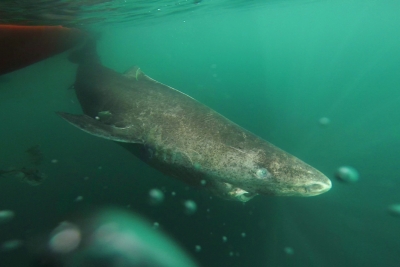
Can you believe that there are sharks that can live for over 400 years? Greenland sharks have the longest known lifespan of all vertebrates on Earth. Scientists estimated the age of a Greenland shark to be about 400 years in 2016. It is said that they do not even reach sexual maturity until they are about 150 years old.
Greenland sharks are rarely encountered by humans. They are thought to prefer colder, deeper environments but may be found anywhere between the sea surface and depths of 2,200 meters (about 7,200 feet). Greenland sharks are slow-moving, typically swimming at rates of less than 3 km (about 1.9 miles) per hour. They are carnivorous, and their diet is often made up of several different types of fishes, including smaller sharks, eels, flounders, and sculpins. Crustaceans, seabirds, and carrion—as well as terrestrial mammals (such as horses and reindeer) that likely fell through the ice—have been found in stomach analyses of the species. Greenland sharks are not considered dangerous to humans, in part because they live in regions where people do not typically swim; the only known report of a possible attack by a Greenland shark on a person dates to 1859.
Greenland sharks are considered to be a near-threatened species by the International Union for Conservation of Nature. The species was valued for its liver oil; about 114 litres (30 gallons) of liver oil can be obtained from a large specimen (see also fish oil). (Although the flesh of the Greenland shark may be eaten, it is toxic unless properly cleaned and dried or repeatedly boiled prior to consumption.) Greenland sharks were fished commercially from the 19th century until 1960. Norway persecuted Greenland sharks during the 1970s, because they were considered to be a nuisance that threatened other fisheries. In the early 1900s as many as 30,000 Greenland sharks were caught a year. In the present day the annual take is far smaller; small-scale subsistence fisheries in the Arctic harvest fewer than 100 individuals annually, and roughly 1,200 are caught accidentally in fishing trawls.
Credit : Britannica
Picture Credit : Google



